Evidence-Based Design Influences Interior Design
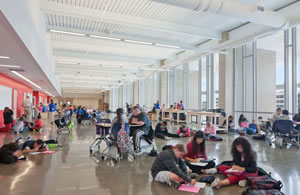
PHOTO BY JONATHAN HILLYER COURTESY OF PERKINS + WILL
When architects and interior designers work on a school project, they have a number of goals to accomplish. Sustainability is a common goal. Meeting code is obviously another. A third is meeting the needs of the client. “We want to understand the client’s academic goals,” says John Fabelo, AIA, a partner with Dayton, Ohio-based LWC Inc. “We want to know what the client wants the project to do and say.”
And yet a fourth goal is creating an environment that is conducive to learning. How is that goal met? Through life experience, through knowledge: discovering what others have done that has or hasn’t worked, and through evidence-based design (EBD).
What is evidence-based design?
According to the Center for Health Design (www.healthdesign.org) in Concord, Calif., “Evidence-based design is the process of basing decisions about the built environment on credible research to achieve the best possible outcomes.” The nonprofit organization’s mission is to transform healthcare environments for a healthier, safer world through design research, education and advocacy.
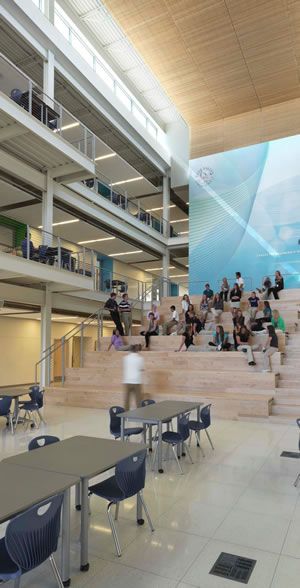
PHOTO BY JAMES STEINKAMP COURTESY OF PERKINS + WILL
If EBD influences the design of healthcare environments, why not also apply it to the design of education environments? The good news is that it is being applied to education: “… EBD is making inroads into being part of the process for designing schools, office spaces, hotels, restaurants, museums, prisons and even residences,” says David Whitemyer in The Future of Evidence-Based Design, published on the International Interior Design Association (IIDA) website (www.iida.org/content.cfm/the-future-of-evidence-based-design). “The amount of well-researched building and user information keeps growing,” he adds.
Daniel R. Mader, AIA, CEFP, LEED-AP, chairman/chief executive officer of Fanning Howey and chair elect of CEFPI, indicates that EBD is not a new concept. “We’ve been calling it research-based design,” he says. “EBD is the new designation. I believe very strongly that we’ve always had a lot of anecdotal evidence and there is more and more rigorous scientific research available to inform school design. It’s a combination of scientific and anecdotal research that colors everybody’s perspective on things that are important in the design process.”
EBD value and application
Architects and designers desire to create high-quality learning environments. Doing so is largely intuitive. “There are no hard and fast rules,” says Karen Painter, IIDA, ASID, LEED-AP, a partner emeritus in LWC’s Interior Design department. “It’s a balance of a number of things, including color, texture/shape and proportions, that need to be worked together.”
Creating high-quality learning environments begs the question, how do we know that what we do when creating high-quality learning environments affects how students learn? The answer is EBD. “There have been a lot of tests and statistics on environments in general — about humans using a space, not just in terms of learning — and how environments affect people in terms of how we think, our blood pressure and more,” says Fabelo. “Studies show different colors can sooth or excite us. Controlling those emotions can affect capturing a child’s attention in a learning environment.” For example, you may want to use red in high-energy spaces and blue in more relaxed spaces.
“It’s EBD,” Painter agrees. “There has been case study after case study and practice-based design scientifically conducted with proven benefits. These are real studies that have been confirmed.”
EBD also has value in explaining that a well-designed education space includes consideration of many physical facets, such as room size, thermal comfort, acoustical characteristics, artificial and natural light, indoor air quality and more. “Research indicates a correlation between being too hot or too cold and concentration falling off,” says Steven Turckes AIA, LEED-AP, REFP, K-12 education global market leader for Perkins & Will. “Research also indicates that, in an average classroom in the United States, students hear 75 percent of what’s said. That’s problematic for young children, who don’t have the ability to fill in context. And research indicates a link between a well day-lit space and improved test scores on standardized reading and math tests.
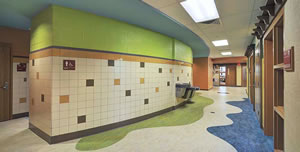
PHOTOS COURTESY OF LWC INC.
ABCs of EBD. Evidence-based design is the process of basing decisions about the built environment on credible research to achieve the best possible outcomes. At Huber Elementary School in Huber Heights, Ohio, above, designers used colors to sooth or excite to help capture the students’ attention in the learning environment.
“So, all those physical characteristics play an important role,” Turckes continues, “and we want to get them right. We want mechanical systems that aren’t too loud, air at an appropriate temperature and high-quality in terms of IAQ, and a well day-lit space.”
Turckes also points to burgeoning research about the correlation of material selection and health in creating high-quality learning environments. “Beyond and along with good IAQ,” he says, “we want to make sure that the materials chosen aren’t contributing to IAQ problems. Whether floor coverings, paint or fill-in-the-blank, we must choose products that are not off gassing VOCs and are, hopefully, rather neutral in terms of contribution to contaminants in the space.”
Mader agrees, observing that many EBD topics overlay, and are in agreement with, many of the issues that are associated with sustainable design, such as IAQ, natural light and acoustics. “It’s interesting that a research-based approach and a sustainability approach to the best environment in which to educate students both come to the same conclusion,” he says.
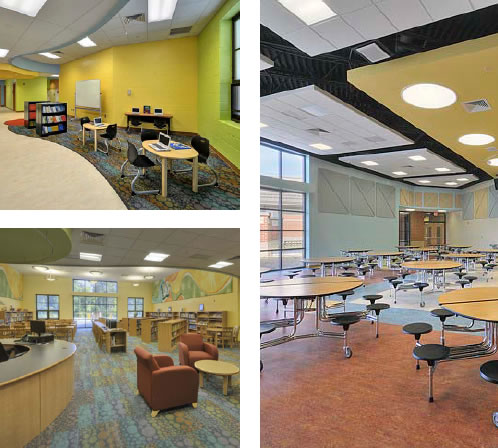
Also in agreement, Fabelo cites a study he read in a book about sustainability. Two apartments in an urban area both featured plazas. In one plaza, the trees were cut down to create an open space. In the other plaza, the trees were left untouched. Tenants in the building that had trees in its plaza had a better outlook on life and better paying jobs than tenants in the building that had no trees in its plaza. “The book shows how the connection to green improves our quality of life,” he sums.
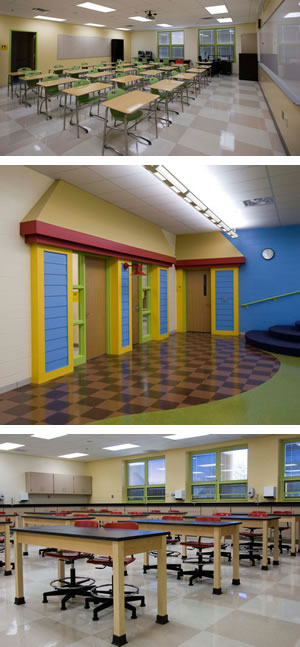
PHOTOS COURTESY OF LWC INC.
Clearly, EBD covers design and sustainability. And Mader notes that it covers an entire gamut of issues. “Given the scope of what we’re dealing with when designing schools,” he says, “such as student and teacher performance, absenteeism and health, operational issues and approaches to reducing energy costs and water consumption, it covers so much more than creating environments in which students thrive.”
Believers in the value and application of EBD to schools can’t help but ask, how does a design professional determine what study results are worth their salt and which should be thrown out? The answer is with a little common sense. “I think you evaluate research the same way you evaluate all the decisions you make in the design process,” says Mader. “You look at the credentials of the people promoting a position. In many cases, particularly where EBD is school related, there tend to be multiple studies on the same topic, so you can take comfort conclusions that come out some of rigorous studies is what people have known or suspected anecdotally, it’s nice to have the research to back it up.”
EBD certification
Because EBD is so valuable, architects and designers are promoting it. For example, the Center for Health Design has an Evidence-based Design Accreditation and Certification (EDAC) program. Experts demonstrating an understanding of how to apply an evidence-based process to the design and development of healthcare settings — including measuring and reporting results — are awarded EDAC credentials.
Similarly, CEFPI, whose mission is improving the places where children learn, also has rolled out a certification program called Certified Educational Facility Planner (CEFP). According to the CEFPI website (www.cefpi.org), the certification “is designed to elevate professional standards, enhance individual performance and identify those in the educational environment industry who demonstrate the knowledge essential to the practice of educational facility planning.”
“The program has been in the works for a couple of years,” says Mader. “It’s a comprehensive curriculum entailing all the process of educational facility design, and EBD is an important component of the curriculum. We now have our first class of certified planners.”
CEFP certification is a three-step process. The first step is meeting eligibility requirements. The second step is passing a CEFP exam. And the third step is meeting continuing education requirements.
In addition to the CEFP program, CEFPI is promoting EBD at every level — chapter, region and international — via conferences, symposiums, Webinars and publications. “All of those vehicles are used to help share best practices and connect people with EBD research,” Mader acknowledges. For example, the more recent issue of CEFPI’s member publication, Educational Facility Planner, includes a case study about applying EBD to the design of a 50,000-sq.-ft. tech school.
EBD, already around for many years and known by other names, now has one name and is consistently applied when creating education environment where all building occupants flourish. “As construction costs rise, codes increase and human-centered considerations flourish, clients will demand accountability and data-proven justification for most design decisions,” says Whitemyer. “Interior designers, in their effort to remain both competitive and innovative, will seek strategies that allow their expertise to shine. Technology will improve the ease and availability of existing research, and will improve digital user-feedback and data gathering systems. It’ll be a group effort.”
This article originally appeared in the School Planning & Management July 2013 issue of Spaces4Learning.